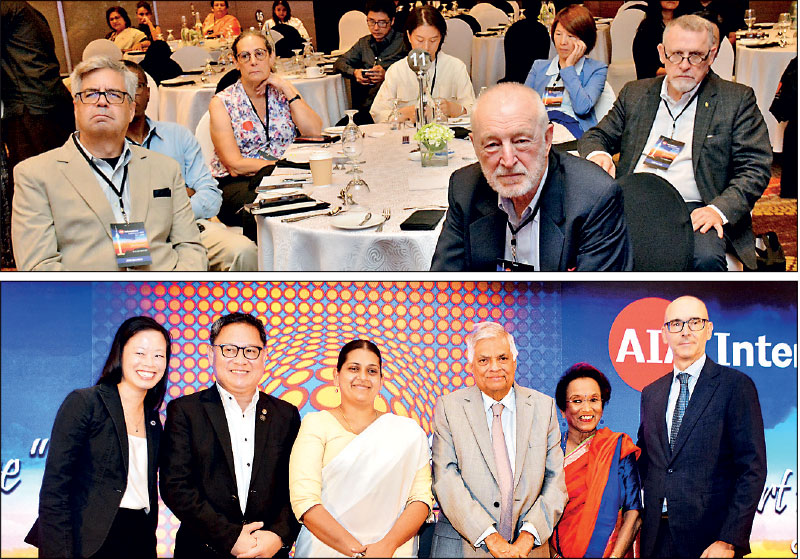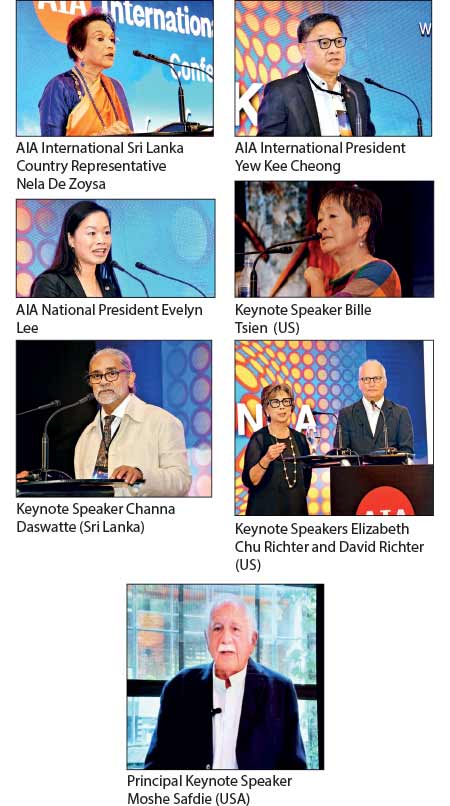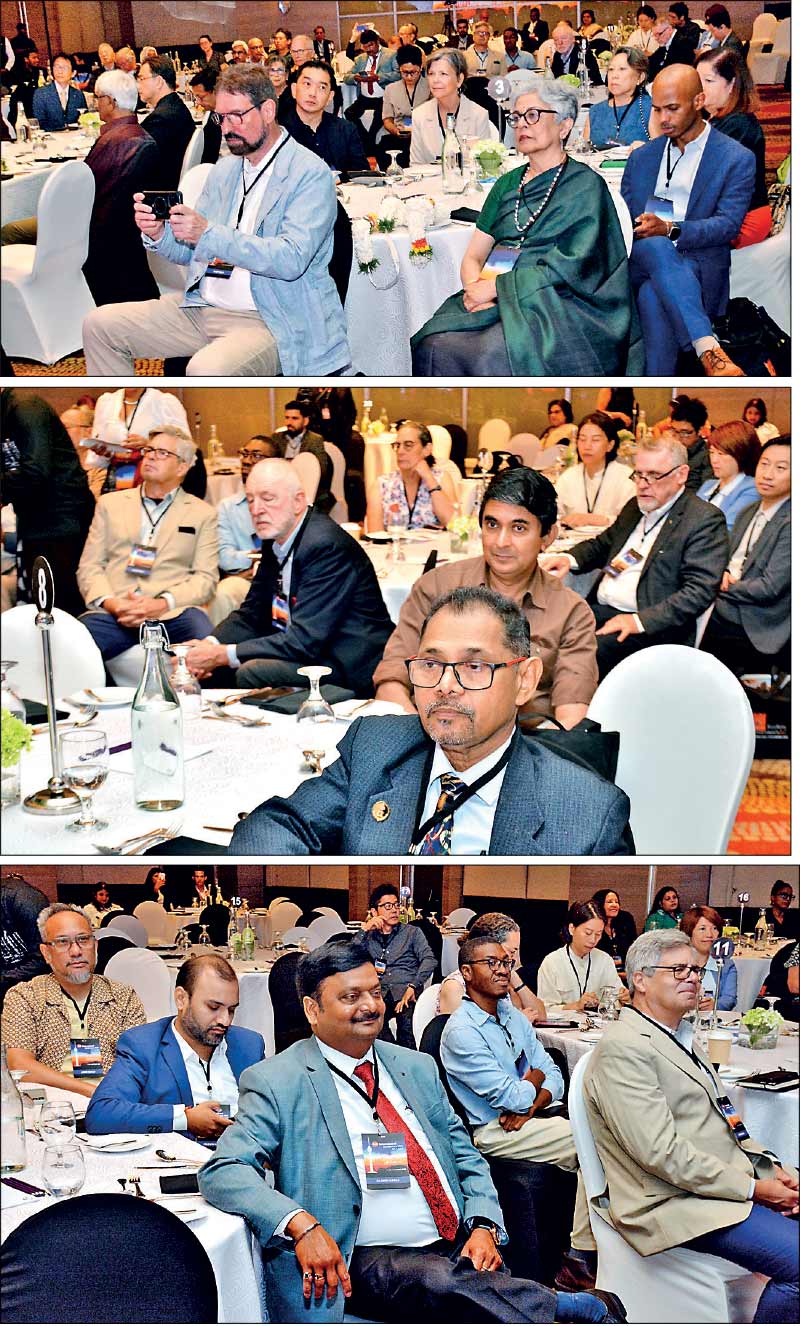Friday Dec 05, 2025
Friday Dec 05, 2025
Friday, 10 October 2025 06:03 - - {{hitsCtrl.values.hits}}

By Divya Thotawatte
 Spotlighting Colombo in the global architecture scene, the American Institute of Architects (AIA) International Conference 2025 kicked off yesterday, marking the second time Sri Lanka has hosted this prestigious event.
Spotlighting Colombo in the global architecture scene, the American Institute of Architects (AIA) International Conference 2025 kicked off yesterday, marking the second time Sri Lanka has hosted this prestigious event.
The conference, themed ‘The Art within Architecture,’ will be held from 9-11 October at Cinnamon Grand Colombo. Its inauguration gathered some of the world’s most celebrated architects, together with other influential local and international personalities, including key representatives from the AIA, local political figures, and ambassadors. Mayor of Colombo Vraie Cally Balthazaar and former President Ranil Wickremesinghe were present as Guests of Honour.
Speaking at the event, AIA National President Evelyn Lee highlighted the necessity of a climate-conscious and human-focused approach to architecture in the delicate and rapidly-changing state of the current world.
“It’s hard to talk about Sri Lanka’s incredible natural and cultural landscape without thinking about how fragile these gifts are, and how much responsibility we have as architects. Rising sea levels, extreme weather events, and the depletion of natural resources are not abstract challenges; they are real. Their realities shape our work right now.”
She further stressed that, as a global profession, architecture was falling behind and was insufficient with regard to climate action. It was therefore necessary to act with urgency and optimism, designing buildings that both minimised carbon impact and safeguarded human health and wellbeing, Lee said.
The conference included world-class speakers who engaged the audience of professionals in thought-provoking discussions, sharing expertise and perspectives on key industry topics.
Renowned Israeli, Canadian and American architect Moshe Safdie delivered the event’s principal keynote speech, where he reflected on humanity’s evolving relationship with nature in cities. “Our connection as a species to nature—our dependence on it—is fundamental to our sense of well-being.”
Safdie traced the arc of urban design from the early 20th century, recalling Ebenezer Howard’s Garden City for Tomorrow, conceived as a reaction to the industrial cities of the 19th century. He explained that, at the time, with a world population of 1.6 billion, the idea of a low-density garden city had appeared realistic. However, today, with 8.2 billion people, the world’s megacities are depriving humans of outdoor spaces and a connection with nature.
He also spoke of his lifelong pursuit to “reinvent the apartment building,” leading to his iconic Habitat 67 in Montreal. “The notion here was to have membranes of housing, hills without the hills, terraces upwards, and gardens open to the sky. Every house had its own garden and access to open streets, daylight, and was nature-integrated. This proposal did not get realised because of a shortage of time and funds.”
Safdie explained that subsequent projects across China, Singapore, and Colombo continued this mission to remain vertical living, creating spaces that offered more comfort and connection than the typical apartment block. He called for a return to the principles of the public realm, where the city was a shared space for people and nature.
“We’ll have to find a way to bring nature back into the city. It goes well beyond the idea of a green city—it is also about making the enjoyment of nature fundamental to the conception of the buildings themselves.”
Celebrated US architects Bille Tsien, Elizabeth Chu Richter, and David Richter, and leading Sri Lankan architect Channa Daswatte also delivered keynotes on Day 1 of the conference. Sri Lanka Tourism Development Authority (SLTDA) Chairman Buddhika Hewawasam also delivered a speech during the event.
AIA International Country Representative Nela De Zoysa spoke on the journey of bringing together this international conference in Sri Lanka.
She explained that the absence of an established chapter in the country had posed challenges, but the Sri Lankan team and members had been able to successfully overcome them. “Despite limited funding and numerous setbacks, it was the dedication of our committee and volunteers that made this conference possible.”
During the AIA International Conference 2025 in Sri Lanka, guests are also able to experience architectural tours revealing Sri Lanka’s UNESCO World Heritage sites, tropical landscapes, and the masterpieces of Geoffrey Bawa, one of Asia’s most influential modern architects.
AIA International President Yew Kee Cheong noted that the theme for this year’s conference, ‘The Art within Architecture,’ felt fitting as guests from different foreign countries experienced Colombo’s “chaotic energy with startling contrast in art and architecture.”
“This flagship event is a leadership platform, with each conference leaving behind different legacies and developing approaches relevant to its culture and context. It has strengthened the AIA’s branding, promoting visibility in every region hosted by each city.”
The AIA is a US-based professional organisation that exists to protect and serve architects and design professionals, monitor legislative issues that impact the public and the profession, and recognise and promote excellence in architectural design, technology, and design-related issues. AIA International, formed in 2012 as AIA International Region, is a component of the Institute.

